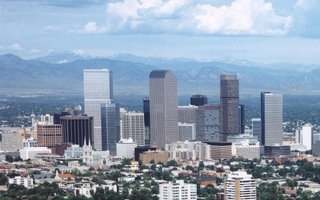
Yesterday we returned from a week-long road trip to Denver. People often remark to me that driving across Nebraska is so boring. I don't agree with them. On this trip, we zig-zagged our way across southern Minnesota through Northfield, south on I-35 and west on I-90 were we caught US 81 west on Sioux Falls, SD and headed straight south to Columbus, NE. It was 100 in Yankton, SD and 102 in Norfolk, NE. Having driven this route intermittently a couple of times over the past 20-plus years, it is interesting to see the growing presence of wind farms along the way.

You cross the Missouri River at Yankton on a double-deck, one-lane bridge and from there to Columbus, NE the road is a straight shot over the gentle rolling hills of northeastern Nebraska. Historically, the Meridian bridge marked the first highway crossing of the Missouri River. The highway that crosses it runs from Winnipeg to Mexico City and is US 81. It was originally called the Meridian Highway. As we drove south up and down the hills past cornfield and herds of cattle, we could see the thunderheads building up to the west of us. As the dark clouds spread our way, it looked like we would get caught up in the brewing storm. As luck would have it, we skirted the southern edge of the storm with only a few drops of rain hitting our windshield. In the rear-view mirror, you could see that all hell was breaking out.

After a night in Columbus, NE, we headed west on US 30 -- also known as the Lincoln Highway -- and drove to Grand Island to meet up with I-80. In that stretch, US 30 runs side-by-side with the Union Pacific railroad line. We met trains coming from the west about every 10 minutes. Those trains we either coal trains or container trains. Despite the rumors, the engineers still do wave from the train.

Once we got on I-80, it was time to make some serious time and get on down the road to Denver. As we drove across western Nebraska and into eastern Colorado, we got to see two different storm cells building. What were small cloud formations in Nebraska were huge, ominous thunderstorms by the time we got to Sterling, CO. The roads gods were smiling on us once again, as we drove between the two storms with only a few minutes of windshield-wiper time in a sun shower. To the north and south, you could see torrential downpours and frequent ground-stabbing lightening displays.

Once we got in sight of the Denver skyline and could see the Front Range running north and south through the haze and pollution, I was reminded of the big-city mystery and innocent-eyed, urban adventure Denver offered me when I first pulled into that city to be a intern at Mountain Bell in 1983. Twenty-three years later, after exiting the rat race of the freeway to get to our hotel, I was quickly reminded it's a nice place to visit, but I wouldn't want to live there.

Behind the hotel were we parked, there was a small man-made pond with a very active colony of red wing blackbirds noisily going about their business. The roar of I-70 just to north blended with the twittering of the red wing black birds and provided us with a moment of contemplation of the co-existence between the man-made and the natural world; a soft spot somewhere between where the rubber meets the road and the bird eggs crackle open with new life.
As far as a boring drive across the plains, I've yet to experience one. There's plenty of history between the Mississippi River and the west coast. Learning some of that history makes the drive more interesting.

No comments:
Post a Comment